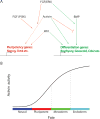The molecular circuitry underlying pluripotency in embryonic stem cells
- PMID: 22761038
- PMCID: PMC5872147
- DOI: 10.1002/wsbm.1182
The molecular circuitry underlying pluripotency in embryonic stem cells
Abstract
Cells in the pluripotent state have the ability to self-renew indefinitely and to differentiate to all the cells of the embryo. These cells provide an in vitro window into development, including human development, as well as holding extraordinary promise for cell-based therapies in regenerative medicine. The recent demonstration that somatic cells can be reprogrammed to the pluripotent state has raised the possibility of patient and disease-specific induced pluripotent cells. In this article, we review the molecular underpinning of pluripotency. We focus on the transcriptional and signaling networks that underlie the state of pluripotency and control differentiation. In general, the action of each of the molecular components and pathways is dose and context dependent highlighting the need for a systems approach to understanding pluripotency.
Copyright © 2012 Wiley Periodicals, Inc.
Figures



References
Publication types
MeSH terms
Substances
Grants and funding
LinkOut - more resources
Full Text Sources

